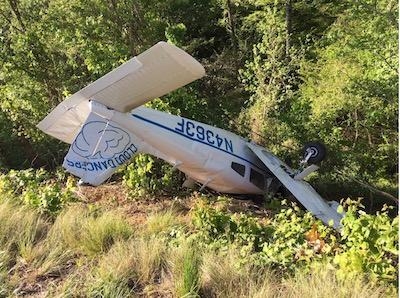Flight Instructor Was Fatally Injured When The Plane Went Down
The NTSB has released a factual report from an accident which occurred on April 28, 2018 involving a Piper PA-28R-200 which struck a parked vehicle during a force landing attempt on a highway after an engine malfunction. The flight instructor was fatally injured; the commercial pilot and passenger were seriously injured. The two people in the vehicle were not injured. The airplane was registered to and was being operated by the Flight School of Gwinnett as an instructional flight. VFR conditions prevailed, and no flight plan was filed for the flight.

According to the report, the commercial pilot who was seated in the front left seat said the purpose of the flight was to practice maneuvers for a single-engine add-on rating to his commercial certificate. After they departed, they flew to the flight school's practice area, which was over Lake Lanier, before returning to the airport to practice landings and traffic pattern work. While returning to the airport in level flight between 3,500 and 5,000 ft mean sea level (msl), the commercial pilot heard a loud bang from the engine and saw the cowling expand simultaneously. Engine oil then sprayed over the entire windscreen and obstructed their view. The engine was producing some power, but the airplane was unable to maintain altitude. The flight instructor, seated in the front right seat, took control of the airplane and made two descending 360° turns over the highway and prepared to land to the west. The flight instructor also made a distress call to air traffic control. The flight instructor opened
the cabin door so he could see outside and aligned the airplane with the road. The commercial pilot was looking out the left-side window. When the airplane was about 20 to 30 ft above the ground, the flight instructor began to flare the airplane. The commercial pilot remembered an impact, then the airplane flipped over. He recalled seeing the top of the fuselage caving in before losing consciousness.
The passenger in the rear left seat was a student pilot at the flight school and was observing the flight. He stated that they had been practicing maneuvers when he heard a loud bang and the airplane began to shake. Oil then covered the windshield from right to left. The flight instructor said they were going to make an emergency landing. The flight instructor opened the cabin door so he could make sure the landing area was clear, because he could not see out the windshield. The passenger said that there was a loud crash sound as the airplane touched down. The next thing he knew he was upside down still strapped into his seat via his lap belt. He unbuckled the belt and exited the airplane.
Several people witnessed the accident and reported that the airplane's engine was sputtering, leaking fluid, and trailing smoke.
A witness was driving westbound on the highway when she saw the airplane fly over her car. She said the pilots tried to land the airplane and struck a vehicle; there was then an explosion. The airplane then went down an embankment.
Another witness was a passenger in a car driving westbound on Highway 369 when she saw something out of the corner of her eye. The airplane then struck the car from behind. Her husband, who was driving the car, said the airplane struck their car, then he saw flames in his rearview mirror before the airplane passed the car on the left and went into a ditch.
The flight instructor held a commercial pilot certificate with ratings for airplane single-engine land and instrument airplane. He also held a flight instructor certificate with ratings for airplane single-engine, and instrument airplane. His most recent Federal Aviation Administration (FAA) second-class medical certificate was issued on December 18, 2017.
The flight instructor's logbook was not recovered. According to information provided by the flight school, as of November 2017, the flight instructor had about 536 total hours of flight experience. The flight instructor began employment at the flight school in December 2017 and had flown about 135 hours between that time and the accident.
The pilot receiving instruction held a commercial pilot certificate with a rating for airplane multi-engine land and instrument airplane, with private pilot privileges for airplane single-engine land. His most recent FAA third-class medical certificate was issued on April 10, 2018. The commercial pilot reported about 560 total hours of flight experience.
The airplane's most recent annual inspection was conducted on February 6, 2018, at an airframe total time of about 5,477.87 hours. At the time of the accident, the airplane had accrued about 5,515.01 hours.
The engine's most recent annual inspection was conducted on February 6, 2018 at a total time of 1,033.97 hours and the engine had accrued 1,071.11 hours since major overhaul at the time of the accident. The overhaul was conducted in July 2014, at which time the crankcase was reassembled and all four cylinders were installed. Review of maintenance records did not reveal any cylinder removals or crankcase disassembly since the overhaul.
(Source: NTSB. Image provided by the Forsyth County Sheriff’s Office for the NTSB accident docket)
 Classic Aero-TV: Active Winglets -- Tamarack Aerospace Partners with Cessna
Classic Aero-TV: Active Winglets -- Tamarack Aerospace Partners with Cessna Aero-News: Quote of the Day (05.03.25)
Aero-News: Quote of the Day (05.03.25) ANN's Daily Aero-Term (05.03.25): Taxi
ANN's Daily Aero-Term (05.03.25): Taxi ANN's Daily Aero-Linx (05.03.25)
ANN's Daily Aero-Linx (05.03.25) Airborne 05.02.25: Joby Crewed Milestone, Diamond Club, Canadian Pilot Insurance
Airborne 05.02.25: Joby Crewed Milestone, Diamond Club, Canadian Pilot Insurance



